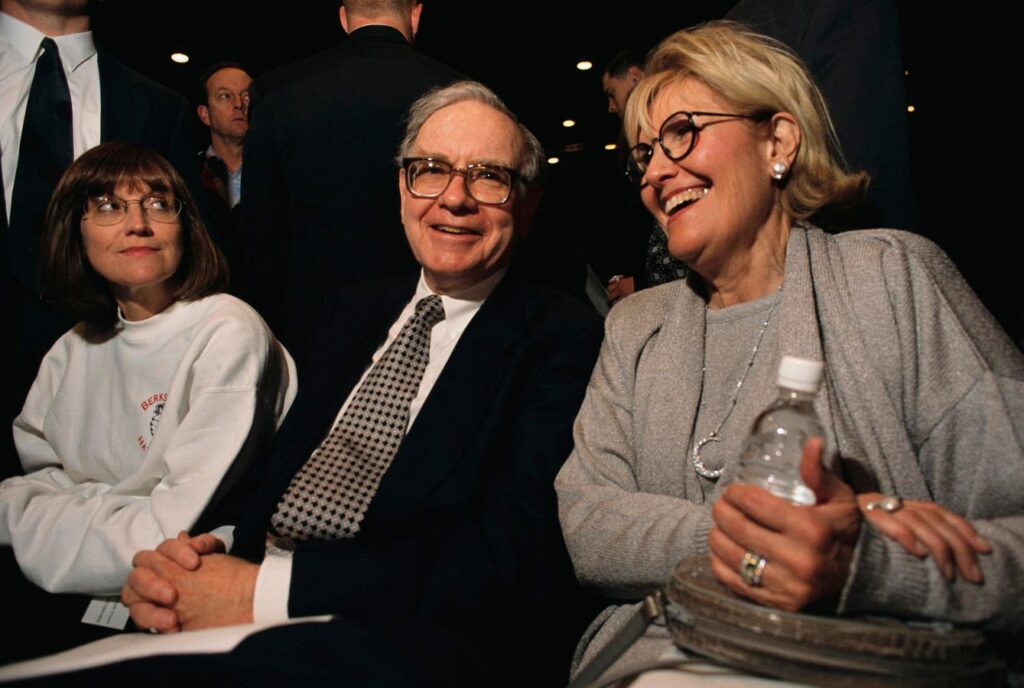“If you’re lucky in life, make sure that a bunch of other people are lucky, too.” – Warren Buffett
In the fourth-floor lunchroom of the National Indemnity Company building in Omaha, Nebraska, a hand-lettered sign once hung on closed double doors: “Meeting in Progress.” Inside, beside vending machines and a coffee maker, Warren Buffett called to order the annual meeting of Berkshire Hathaway shareholders, with approximately 20 attendees present. The perfunctory business was dispensed with in just five minutes. Then Buffett offered: “I’ve got an hour, and if anybody wants to stick around and talk about the investment business, I’m available.”
This modest gathering in the 1970s bears little resemblance to today’s extravaganza that draws tens of thousands of investors from around the world to Omaha. The transformation of this annual shareholder meeting mirrors the remarkable journey of Berkshire Hathaway itself – from a struggling textile mill to a $1 trillion conglomerate under Buffett’s leadership.
The Humble Beginnings
When Buffett gained control of Berkshire Hathaway in 1965, the company was a failing textile business. His first major move toward diversification came in 1967 with the acquisition of National Indemnity Company for $8.6 million, marking Berkshire’s entry into the insurance industry.
From 1969 to 1979, those early shareholder meetings were indeed held in National Indemnity’s lunchroom, with attendance rarely exceeding two dozen people. Most were friends, family, and early investors who had placed their trust in a young Warren Buffett, well before he became a household name in finance.
The Growth Years
As Berkshire’s portfolio and prestige grew through the 1980s, so did the annual meeting. The gathering outgrew the lunchroom and migrated to progressively larger venues: the Red Lion Hilton, the Witherspoon Concert Hall at the Joslyn Museum, and the historic 2,000-seat Orpheum Theater in Omaha.
By the 1990s, attendance had swelled into the thousands. The Holiday Inn Convention Center became the next stop, followed by the 10,000-seat Civic Auditorium. It was during this period that the event began its transformation from a standard corporate meeting into something more akin to a festival of finance.
The Addition of Exhibitors
In a stroke of marketing genius, Buffett began showcasing Berkshire’s growing family of companies at the annual meetings. Attendees could purchase See’s Candies, browse furniture at Nebraska Furniture Mart, or shop for Fruit of the Loom apparel. The exhibition aspect turned the annual meeting into both an educational forum and a shopping experience featuring Berkshire’s diverse holdings.
The addition of these exhibitors not only demonstrated the breadth of Berkshire’s business empire but also created a tangible connection between shareholders and their investments. Suddenly, owning a piece of Berkshire Hathaway meant belonging to a community with shared values and interests.
The Bill Gates Era and Newspaper Tossing Contest
When Microsoft co-founder Bill Gates joined Berkshire’s board in 2004, the meeting gained even more star power. One of the most beloved traditions that emerged during this period was the newspaper tossing contest – a callback to Buffett’s boyhood job delivering newspapers.
Since 2012, attendees have competed to throw rolled-up newspapers toward the porch of a Clayton Home (a Berkshire company) set up inside the convention center. Even Gates has participated, with Buffett often demonstrating proper technique to his friend. Winners receive Dairy Queen Dilly Bars – another Berkshire-owned business.
Woodstock for Capitalists
By 2004, the meeting had moved to its current home at what is now the CHI Health Center (formerly the Qwest Center and CenturyLink Center), with a capacity of 20,000 in the main arena and space for another 20,000 in supplemental areas. The 2014 meeting completely sold out this massive venue.
Today’s Berkshire Hathaway annual meeting – aptly nicknamed the “Woodstock for Capitalists” – attracts more than 40,000 attendees from across the globe. The actual business portion takes a modest 20 minutes, while the famous question-and-answer session with Buffett and his late partner Charlie Munger stretched for five-plus hours, covering topics from investment strategy to global economics.
What makes this annual pilgrimage to Omaha so special isn’t just the investment wisdom shared by Buffett, but the celebration of free market capitalism done right – where companies focus on creating long-term value rather than short-term gains.
Charlie Munger once remarked that what Warren Buffett is most proud of is being a fiduciary for millions of people. Through Berkshire Hathaway, Buffett has indeed created a vehicle that has generated wealth for countless individuals who trusted him with their savings.
The evolution of Berkshire’s annual meeting reflects Buffett’s philosophy itself – start small, think big, and always remember that business is ultimately about people. From a humble lunchroom gathering to a global phenomenon, the Woodstock for Capitalists stands as a testament to how capitalism, when practiced with integrity and long-term vision, can create value for all stakeholders involved.
Read the full article here

